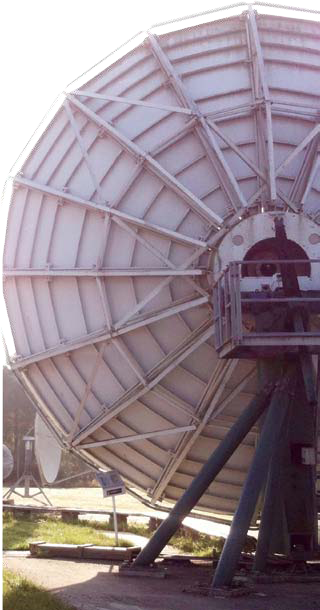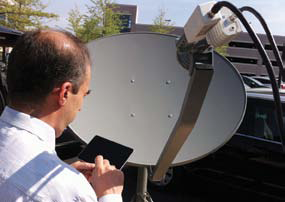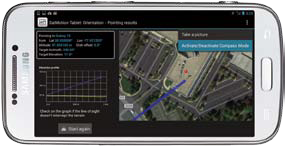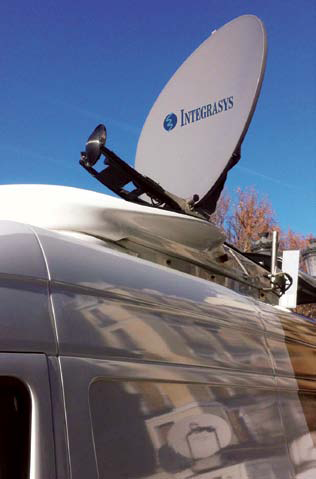Today, more than one million households access the Internet via broadband satellite. A new satellite generation with 10 times more capacity will catch three million users in the coming years.

This is the situation in the United States and similar conditions are resident in other regions of the world such as South America and Central Africa. This technology represents a revolution similar to that of the satellite TV Direct-To-Home (DTH) reach in the 90s. This implies a massive deployment scenario with no precedents as to the challenging economic and technical issues that must be confronted. Integrasys has developed the appropriate tool that helps to make this technical breakthrough possible.
Traditional VSAT Installation Methods
VSAT terminal installation can be a time consuming procedure. One must align the antenna, adjust the feed’s polarization and set the modem transmit power, among other procedures. Often, the installer is dependent on Network Operations Center (NOC) operations’ staff that use NOC instruments to remotely drive installer’s line-up actions via a phone conversation. The nature of this procedure, with no possibility for the installer to check the uplink signal status in real time after the install, makes it nearly impossible to achieve optimal performance and minimize interference.
The Satmotion Pocket Line-Up method
The Satmotion system is a software-based tool that allows VSAT installers to autonomously visualize and measure their uplink test signal—normally a clean carrier—in the field with no need to coordinate with NOC personnel. Uplink signal measurements are taken at the NOC site with a commodity spectrum analyzer and a controlling software server. The installer gets measurements from the outbound of the target satellite through the same VSAT that is commissioned.
The received information is displayed on a software client using a computer device of the installer’s choice, such as a laptop, tablet or Smartphone. High-rate traces of different flavors of the uplinked signal as received at the NOC (nominal, cross-polar, adjacent satellite interference) are sent back to the installer in order for fine alignment of the antenna/feed orientation to be completed. Additionally, the transmit power setting can be programmed without a NOC’s support, thereby achieving the VSAT optimal performance.
This system is based on a Carrier Monitoring System, which allows the reception of the hub´s spectrum analyzer measurements in the field without a cellphone connection, just with a satellite link. This capability allows for a full auto-commissioning process without calling to the NOC for support; all the measurements and preventions of any interference are automatically controlled by the hub operations.

Field VSAT installer using Satmotion Pocket app. Photo courtesy of Integrasys.
Satellite network operators struggle to serve the increasing bandwidth demand with VSAT installers carrying professional instrumentation equipment to the customer sites, while supported by staff at the NOC. In these situations, the alignment of a small dish with the satellite, usually in challenging locations and in adverse weather conditions, can be time-intensive and expensive.
The Satmotion system automates control center support and allows the satellite connection to be established with a Smartphone app or computer software at the customer’s site. This auto-commissioning system is reliable, easy-to-use and opens the door for accurate installation by the end customer.
With this unique system, the installer has a ground reference for the initial pointing, maps of the location with target elevation and azimuth information, and a line to the satellite. When the antenna is pointed correctly, the modem provides the Signal to Noise (SNR) value, reading from the downstream carrier, ensuring the installer has pointed the antenna to the correct satellite.
The app displays the measurements performed at the hub to enable the installer to transmit a clean carrier (CW), measuring the power and interference generated by the VSAT in real time. In order to minimize the Cross-Pol and Adjacent Satellite Interference, it rotates the orthomode and moves the antenna. When these interferences are minimized, the app measures the BUC compression point. As a final step, all installations are followed with a log file containing all of the recorded values during the process for power, XPOL, ASI, and many more.

Satmotion app with maps on a Samsung cell phone.
The Benefits
- No more calls to the NOC
- No more Cross Pol (XPOL) interference
- Minimizing Adjacent Satellite Interference (ASI)
- Reduces human factor errors
- Most accurate measurements available in the field
- No more telephone connections required
- No more expensive Spectrum Analyzer in the field required
- Allows for simultaneous installers in different locations
- Maximum CW carrier power, automatic BUC compression point calculation
- Frequency fixed by the hub
- App control
- Optimal performance
Cost Efficiency
Auto-commissioning systems significantly reduce the installation costs. Integrasys completed a study which explains how—for 5,000 VSAT deployments during one year—Satmotion Pocket reduced the cost by 2.8 million euros in the developed countries and 3.2 million euros in developing countries, based on a PWC study for the European Space Agency (ESA). These savings define this system as an economical remote commissioning method.

Simplifying Broadcaster Lineups
With large-scale televised sporting events, the satellite industry is confronted with the issue of millions of antenna line ups per day; this can require additional man hours and cause confusion with the line up demand. Integrasys developed Satmotion SNG that simplifies these line ups and provides the broadcaster with the hub measurements in order to speed up this process.
This system provides the most accurate co pol, cross pol, and ASI information in real time directly to the broadcaster’s Smartphone, on the specific booking frequency assigned by the Satellite Operator, measured at the NOC and sent by cellphone connection.
This app allows the broadcaster to call and talk at the same time, so it could be used for auto-commissioning or to help the broadcaster minimize interference. The technology can also reduce the line up booking bottlenecks at the NOC, minimizing the time on each call.
Who Uses Auto-Commissioning Systems
Satmotion Pocket is used by satellite operator NOCs, satellite service providers and VSAT equipment manufacturers with huge success.
One example is iDirect, a world leader in Satellite IP communications. This software and hardware equipment manufacturer has been testing Satmotion Pocket since early 2013. With iDirect remotes now compatible with Satmotion Pocket, iDirect customers are able to automate the remote commissioning process with the most powerful VSAT line up technology and ensure accuracy. It also minimizes cross pol (XPOL) and Adjacent Satellite Interference (ASI) increasing bandwidth efficiency and savings maintenance costs.
The following organizations have been also an important contributor to this advance technology success: Global VSAT Forum (GVF), satellite Interference Reduction Group (iRG) and the World Teleport Association (WTA).

For additional information, please visit the company’s infosite at http://www.integrasys-sa.com/
About the author
Alvaro Sanchez is the Sales and Marketing Manager at Integrasys, responsible for the International sales in the Integrasys worldwide market and US office. Alvaro is also responsible of the Satellite Product Line.


